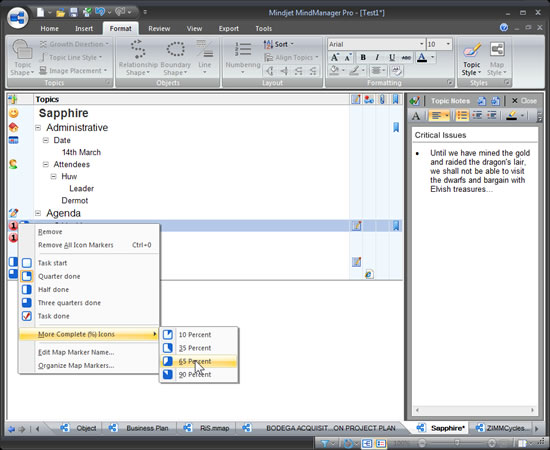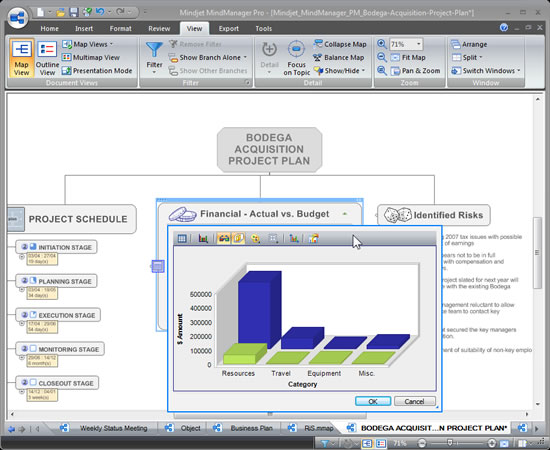Drag, drop, click and map - the MindManager way to plan a project
My cynicism no doubt derives from experience with numerous programs over the years which claim to offer a shortcut to creative thinking. Invariably my initial high expectations have rapidly given way to the realisation that clever software packages do not make me think clever thoughts.
That being so, you might suppose that I would have nothing positive to say about MindManager. Not so. Having overcome my initial scepticism, I now find that I not only like this software but I also find it darn’ useful.
Maps and Projects
In spite of the name, there is more to MindManager than ‘thought processing’. By all means, if you find it useful to jot down random thoughts and then make creative connections between them, you can certainly use MindManager to do so. On the other hand, if what you really need is a tool for creating a carefully structured project plan, MindManager can do that too. In fact, MindManager is useful as a means of creating any kind of plan in which multiple items - people, resources, events and so on - are linked in some interdependent way. So, whether you need to plan a marketing campaign or a software development project, MindManager could be the tool for the job.
I say it could be for the simple reason that its usefulness to you will depend on how you tend to think about information in general. If you think in rows, columns, dates and figures, Microsoft Project is probably a better bet. If you think visually or just want the freedom to ‘try things out’ before arriving at a fixed plan or schedule, MindManager might be more to your taste. In fact, it’s even possible to share documents between MindManager and Microsoft Project (and various other project planning tools) by importing and exporting tasks.
How It Works
Let me explain, briefly, how MindManager works. Essentially it lets you create charts in which labelled items can be linked together to display relationships. In this way you can quickly create hierarchical charts with branches descending from a single root or complex multi-linked charts where branches spread out from a central node, say, or even contain cross-links between one set of nodes and another like a map of the London Underground.

Here, I’ve switched to Outline view to view my project as an indented list
What you do with these charts is entirely up to you. In principle you could use them to do anything from generating ‘family trees’ of people or programming language classes to managing business development tasks in which networks of resources are linked graphically. Then again, if you want to use it as a brain-storming tool, you might start out by entering ideas or tasks ‘free-form’ - scattered around a page with no relations defined and then, gradually refine the plan by drawing links between items to try out varying relationships.
The items in a chart or ‘map’ are not merely static boxes and labels. They can be configured in a variety of ways by assigning to them properties such as priorities and dates. Some properties can be assigned by selecting items in the toolbar; others are assigned using docked panels such as the ‘Task Info’ panel in which start and end dates or the expected duration of a task may be specified. The progress of a project can be tracked by making specific items as 50%, 75% or other percentage (up to 100%, naturally) ‘complete’. Dependent relationships can be represented between items in the form of lines representing links.
Putting On The Style
In addition to the purely functional items that can be assigned to maps, there are also a number of useful presentational features available - things that can make the map just look nicer. You may, for example, change the shapes, colours and fonts of topics (the boxes and text they contain) or alter the display styles and ‘curviness’ of the lines connecting them.
You can also annotate maps by attaching text notes which can be edited in a separate window. You can even attach ‘linked’ notes saved into Microsoft Outlook. MindManager provides a number of links to Office applications. You can, for example, link to a range of cells in Excel or import a Word Outline and convert it into a map. You can also export a map to Word or PowerPoint, save it as an image or a PDF file - or even create a web site based on the map. A web site may optionally include a dynamic (JavaScript) table of contents to let the user navigate through an outline of expandable headings and load up pages corresponding to specific information (resources, dates, people and notes) in the map.

Here is a more complex map (a MindManager sample) which adopts a ‘family tree’ structure and includes some spreadsheet data and a chart.
The user interface of MindManager has the new Microsoft Office-style ‘ribbon’ - a tabbed bar containing related groups of buttons and combo-boxes. I admit frankly that I am no fan of the ribbon in Microsoft Office itself. As a long-time Office users, I’ve found that it actually makes the software harder to use - features whose locations I used to know on the old-style menus are now hidden somewhere in the unfamiliar new interface.
I have no previous experience of MindManager, however, and I have to say that my response to the ribbon has, in this case, been more positive. It seems well suited to hosting the many click-and-select items such as the menus containing graphic markers and styles.
There is plenty of help and documentation supplied with MindManager and there are sample maps which can be downloaded from the web site. It has a pretty good interactive ‘quick start’ that guides you through the basics using a ‘wizard-style’ sequence of instructional dialogs. In short, it didn’t take me long to start using it pretty effectively.
Overall, I have found MindManager to be a genuinely useful piece of software. If your whiteboard is overworked, you may want to give it a try!